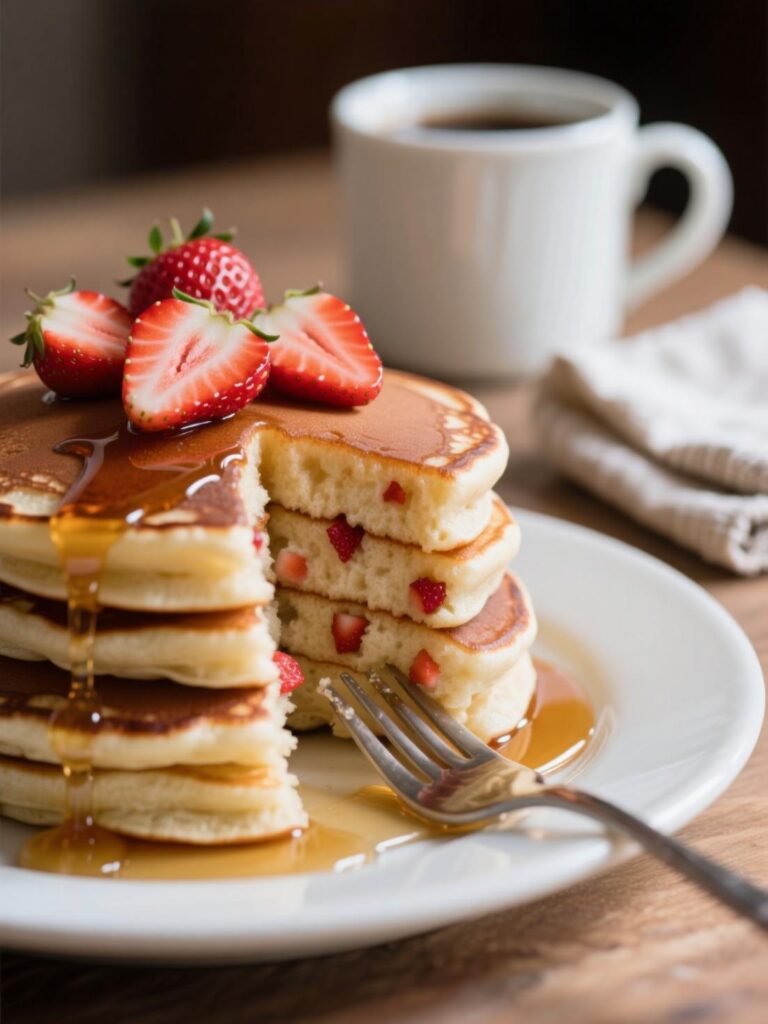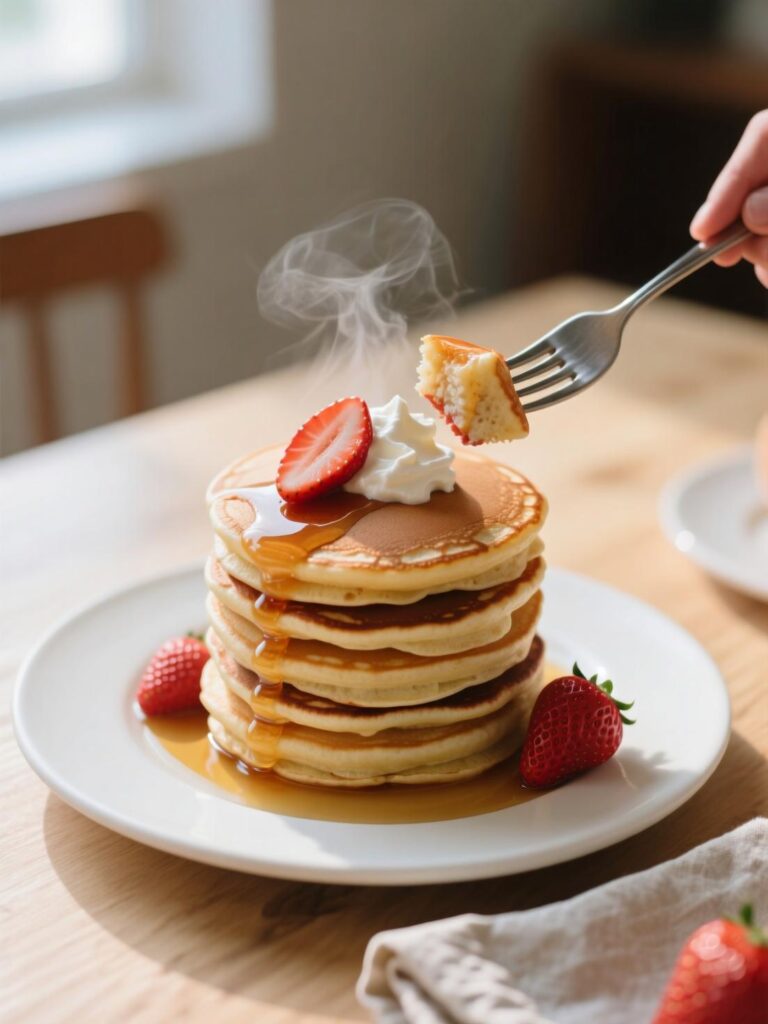You’ve probably eaten strawberry pancakes before, maybe even made them on a lazy Sunday morning. But making pancakes that a professional chef would proudly serve? That’s a whole other thing. This is where science, skill, and a bit of intuition collide. I’m about to break down not just how to make them, but why each step matters. Because once you understand the mechanics, you can tweak, experiment, and own the recipe instead of following it like a script.
Why Strawberry Pancakes Deserve Precision
Pancakes seem simple. Flour, eggs, milk, sugar, maybe some fruit. But in the professional kitchen, “simple” recipes are often the ones where technique separates a decent plate from a wow-I-need-another-bite moment. Strawberries themselves are tricky—they release moisture, their sweetness fluctuates wildly depending on the season, and if you’re not careful, they’ll turn your batter soggy or dull in flavor.
The aim here isn’t just to make pancakes with strawberries in them. It’s to create a balanced bite—crisp golden edges, fluffy interiors, and strawberry flavor that bursts instead of disappearing into the background.
Ingredient Selection – Where Professionals Start
Professional chefs know the quality of ingredients sets the ceiling for the dish’s potential. You can’t go higher than your starting point.
Strawberries: Always taste before using. Winter berries? They’ll need a sugar boost and maybe a pinch of salt to round them out. Peak summer berries? You might even hold back on sugar. Slice them thin if adding to the batter—thick slices release too much juice mid-cook.
Flour: All-purpose is fine for most home cooks, but pastry flour will give a softer crumb. Some chefs mix the two for balance—structure from AP, tenderness from pastry.
Milk: Whole milk brings body. Professionals often cut in a spoon or two of buttermilk for a touch of tang and to help with browning.
Eggs: Large eggs at room temperature. Cold eggs stiffen the batter.
Fat: Melted unsalted butter adds flavor, but don’t be afraid to swap in browned butter if you want a nutty undertone. Just watch the salt content if using salted butter.
The Batter – Gentle Hands Win
A common amateur mistake? Overmixing. Gluten development in pancakes is like an overzealous party guest—fun at first, but ruinous if left unchecked. Mix just until the flour streaks disappear. Lumps are your friends. They hydrate as the batter rests.
Professionals often give the batter a 10–15 minute rest. This lets the starch absorb liquid fully and air bubbles stabilize. It also makes the pancakes rise more evenly and prevents that uneven, “patchy” texture.
For strawberry pancakes specifically, the strawberries should not be dumped in early. Fold them in just before cooking, or scatter them over the batter once it hits the griddle. This minimizes the bleeding of color and moisture.

Heat Control – The Silent Skill
You can’t wing the heat with pancakes and expect perfection. Medium heat is the sweet spot for most stovetops, but every pan behaves differently. Nonstick is forgiving. Cast iron gives unmatched browning but demands precision.
Professional tip: Preheat the pan for a good 5–7 minutes before the first pancake. Test with a small drop of batter—it should sizzle gently, not hiss like it’s mad at you.
Grease lightly. Too much butter or oil fries the edges into a greasy lace. You want just enough fat to prevent sticking and encourage even color.
Cooking with Strawberries – Two Pro Approaches
Chefs debate the best method for strawberry pancakes. There’s the batter-fold method, where chopped berries are folded in right before cooking. This gives soft, juicy bursts inside the pancake but risks uneven texture. Then there’s the surface-scatter method, where berries are sprinkled over the batter once it’s in the pan. This keeps the crumb consistent and allows better caramelization of the fruit on contact with heat.
Some even take it further—roasting the strawberries beforehand. This drives off excess moisture and concentrates flavor. Toss them with a touch of sugar and roast at 375°F (190°C) for about 15 minutes. Now you’ve got strawberries that taste like they’ve been whispered to by summer itself.
Balancing Sweetness – The Professional’s Palette
In pastry work, sweetness is rarely left to chance. With strawberries, you need to account for their natural sugar. If you’re making a syrup or compote to go with the pancakes, pull back on sugar in the batter. You want layers of flavor, not a single cloying note.
Chefs often add a pinch of salt and a hint of acid (like lemon zest or a drop of vinegar) to the batter. It sharpens flavors and stops strawberries from tasting flat. That’s the difference between “yeah, good pancakes” and “these taste alive.”
Garnishes and Accompaniments – Not an Afterthought
The professional mindset treats garnishes as integral, not optional fluff. Whipped cream? Sure, but make it lightly sweetened and maybe infused with vanilla bean. Maple syrup? Go for the real deal, warm it up, and maybe spike it with a dash of strawberry purée for a thematic echo.
Some chefs even drizzle a thin balsamic reduction over strawberry pancakes. Sounds odd until you try it—the acidity makes the sweetness pop, like turning up the contrast on a photo.
Common Mistakes and How Pros Avoid Them
Too much liquid in batter: Leads to spreading and rubbery texture. Measure carefully, and adjust if your flour is particularly soft.
Cooking too hot: Burns the outside before the inside cooks. Professionals adjust the heat mid-service without hesitation.
Adding strawberries too early: Results in grayish, soggy pockets. Always add last minute or on the surface.
Skipping rest time: Leads to uneven rise and gummy texture. Even 10 minutes of rest changes the game.
Professional Variations Worth Trying
Ricotta Strawberry Pancakes – Adds creaminess and density. Works well with roasted strawberries and lemon zest.
Sourdough Strawberry Pancakes – Great for chefs who keep a starter. The tangy base plays beautifully against the sweet berries.
Gluten-Free Almond Strawberry Pancakes – Swap some flour for almond meal. Adds nutty depth and pairs beautifully with a strawberry-maple glaze.
Crepe-Style Strawberry Pancakes – Thinner, with macerated strawberries rolled inside, dusted with powdered sugar. Elegant brunch move.

The Science Behind Fluffiness
The rise in pancakes comes from two key actions: gas expansion (from baking powder or soda) and steam generation from liquid hitting heat. Professionals ensure baking powder is fresh—if it’s over 6 months old, it’s likely lost potency. Some add a splash of seltzer water or club soda to the batter just before cooking for an extra lift.
And here’s the part few talk about—protein balance. Egg protein helps set the structure before steam escapes. Too much egg, though, and your pancakes are rubber bands. Too little and they collapse. Professional ratios hover around 1 egg per cup of flour, but this shifts slightly depending on other fat or moisture sources.
Final Chef’s Recipe – My Tested Approach
- 1 cup (120g) all-purpose flour
- 2 tbsp (25g) sugar
- 1 tsp baking powder
- 1/2 tsp baking soda
- Pinch of salt
- 3/4 cup (180ml) whole milk
- 1/4 cup (60ml) buttermilk
- 1 large egg, room temp
- 2 tbsp melted butter (or browned butter)
- 1 cup fresh strawberries, thinly sliced or roasted
- Mix flour, sugar, baking powder, baking soda, and salt in a bowl.
- In another bowl, whisk milk, buttermilk, egg, and melted butter.
- Combine wet and dry gently. Stop as soon as flour streaks disappear.
- Rest batter 10–15 minutes.
- Preheat pan on medium. Lightly grease.
- Pour batter, scatter strawberries on top. Cook until bubbles form, flip gently, cook until golden.
- Serve with warmed maple syrup, whipped cream, or balsamic drizzle.
Conclusion – Mastery is in the Margins
Strawberry pancakes aren’t just a comfort food. In skilled hands, they’re a canvas for technique, flavor balance, and creativity. The difference between average and exceptional often comes down to those little professional habits—tasting your fruit, controlling moisture, resting batter, and adjusting heat by instinct.
In the end, the goal isn’t just to make pancakes. It’s to create a plate where the first bite makes people pause, look at you, and mutter, “Wow.” And that, in the world of professional cooking, is the only feedback that matters.
FAQs
What is the best type of strawberries for pancakes?
Sweet, firm, and ripe strawberries hold their shape and flavor best when cooked.
Can I use frozen strawberries in pancakes?
Yes, but thaw and pat them dry to avoid excess moisture in the batter.
Why should I rest pancake batter before cooking?
Resting lets starch hydrate and air bubbles stabilize, making pancakes fluffier.
Should strawberries be mixed into the batter or added on top?
Adding them on top while cooking keeps the crumb light and avoids sogginess.
How do I stop pancakes from burning before they cook through?
Cook on medium heat and preheat the pan evenly before starting.
Can I make strawberry pancakes without buttermilk?
Yes, use whole milk with a teaspoon of lemon juice or vinegar as a substitute.
How can I make gluten-free strawberry pancakes?
Swap all-purpose flour for a gluten-free blend or almond flour mix.
Do roasted strawberries taste better in pancakes?
Yes, roasting concentrates sweetness and reduces excess juice.
How do I know when to flip pancakes?
Flip when bubbles form and edges start to look set and dry.
Can I prepare the batter the night before?
Yes, but add baking powder just before cooking for maximum rise.

Mariana is a passionate home cook who creates delicious, easy-to-follow recipes for busy people. From energizing breakfasts to satisfying dinners and indulgent desserts, her dishes are designed to fuel both your body and hustle.
When she’s not in the kitchen, she’s exploring new flavors and dreaming up her next recipe to share with the Foodie Hustle community.

